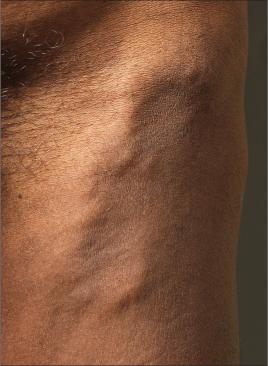Translate this page into:
Subcutaneous zygomycosis

*Corresponding author: Arunachalam Narayanan, Department of Dermatology, Jawaharlal Institute of Postgraduate Medical Education and Research, Puducherry, India. narayanan359@gmail.com
-
Received: ,
Accepted: ,
How to cite this article: Narayanan A, Anurag SV. Subcutaneous zygomycosis. CosmoDerma 2022;2:2.
A 55-year-old male patient presented with a painless, subcutaneous, slowly spreading, disc-shaped, indurated plaque over the anterolateral aspect of the left thigh [Figure 1] for 6 months. Fingers could be insinuated under the disc-like plaque from the periphery of the lesion. There was no history of prior trauma, pain, tenderness, itching, warmth, erythema, or discharge from the plaque. Histopathological examination revealed mixed inflammatory infiltrate in the subcutis with few scattered aseptate fungal hyphae surrounded by eosinophilic material suggestive of Splendore-Hoeppli phenomenon. Based on these clinical and histopathological findings, we made a diagnosis of subcutaneous zygomycosis. Subcutaneous zygomycosis caused by Basidiobolus ranarum typically involves the thighs and buttocks. The infection nearly almost always occurs in immunocompetent individuals.[1] Treatment options include systemic therapy with potassium iodide, itraconazole, amphotericin B, local hyperbaric oxygen, and surgical debridement.

- Painless, subcutaneous, slowly spreading, disc-shaped, indurated plaque over the anterolateral aspect of the left thigh.
Declaration of patient consent
Patient’s consent is not required as patient’s identity is neither disclosed nor compromised.
Financial support and sponsorship
Nil.
Conflicts of interest
There are no conflicts of interest.
References
- Subcutaneous zygomycosis: Report of 10 cases from two institutions in North India. J Eur Acad Dermatol Venereol. 2010;24:1220-5.
- [CrossRef] [PubMed] [Google Scholar]





